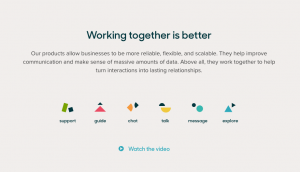Every month or quarter, leaders in most organizations report on the state of business performance. We are strong proponents of taking an outcome-based approach to performance measurement and management. Best-in-class leaders focus on what’s happening both, inside and outside, of their company, to strengthen business performance. Optimize these four key “outside” factors to achieve greater success:
- Customer-Centricity
- Partner and Supplier Relationships
- Competitive Intelligence
- Market Data
BCG studied the tenures of 7,000 CEOs worldwide to identify how they affected their companies’ business performance trajectories. The one success factor associated with high CEO performance across all contexts was this: a long-term, externally oriented approach to strategy. That is, they are more outside than inside focused.
Most leaders inherently understand this approach, which is why the 1989 commercial from United Airlines in which the CEO hands out tickets to his team to meet with customers still resonates today. If as a leader the majority of your working day, most every day, is spent addressing what’s going on internally with your organization, it may be time to re-allocate your energy and time. Give some thought to the last few weeks. How many of the meetings you attended, and the conversations you had, were with or about new and existing customers, partners, or competitors? How much time did you spend keeping a pulse on your industry and your market? If you answered not as much as you would have liked, then it’s time to make a change.
Four Focal Points of Business Performance Improve Competitiveness and Customer-Centricity
In our CEO conversation with Becky Taylor for the Ready, Set, Grow! Funnel Media program, she emphasized how critical it is for leaders to “maintain a 360-degree view, or an ‘up-periscope,’” in order to be able to adjust quickly, or as close to “real time” as possible.
Improving business performance takes regular review of your financial, operational, and customer data from various, disparate sources. The insights from this data is one essential part of having a complete view of your business, but you also really need to know your:
- Customers. A 360-degree view of a customer entails more than collecting customer data, from basic contact information, to past and present purchasing data, and all interactions with your organization. A study in the Harvard Business Review found that the average CEO spends 72% of their time in meetings and only 3% of their time with customers (about two hours a week). Business leaders set the tone and priorities for their organization. They model the way. To improve business performance, commit every leadership member to invest at least 10% of their time thinking about, talking to, and steering the organization to being more customer-centric. If you’re a member of the leadership team, take the initiative.
- Partners and Suppliers. Your partners and suppliers serve a strategic role in your organization. In the B2B world, companies often establish close-knit, long-term relationships with whom they do business. B2B organizations might not have many partners and suppliers, but often these relationships are extremely important to the success of the business, and the ability to deliver on promises to customers. If a partner and/or supplier relationship is managed poorly, it could potentially put your business in jeopardy. Most organizations participate in formal supplier reviews. These are valuable especially when it comes to managing the most important relationships and improving business performance. It is a critical component of performance management. Think about it. Is that the only time you want your customers to engage with you? Is the only communication with a customer during a review? How deep of a customer relationship can you forge? Solid relationships with suppliers and partners can be instrumental to addressing unexpected market changes and demands. At Motorola, every strategic supplier and partner is assigned to key members of the leadership team with whom they meet at least quarterly. We encourage you to do something similar and focus these relationship meetings on critical issues and gaps and discussions on opportunities to improve the relationship.
Competitors. When it comes to being on the field, or in any other competitive venue, the best athletes focus on reading their competition and responding accordingly. They become hyper-focused on how to perform at their optimal level with every passing moment of competition. They come prepared for most every scenario, having reviewed video and other information about the competitor. Competitor analysis provides valuable insights into how to run your business. Competitive analysis goes beyond conducting win/loss analysis. Solid competitive analysis enables you to develop your unique value proposition, prioritize your product or service innovation roadmap, identify and address gaps between what your competitors offer and what your customers need, improve and adjust your marketing and selling strategies and tactics, gain insight into your competitiveness, and identify potential new market segments and customers. In addition to gaining insights directly from customers about competitors, solid competitive analysis examines the competitors’ offers, pricing, sales and marketing tactics, technology stacks, social media engagement, website navigation, content, social media presence and activity, and third-party news coverage. We recommend gathering competitive intelligence and completing an analysis on existing and up-and-coming competitors on a quarterly basis, more frequently when you find that a particular competitor is regularly winning against your organization. Create a database to capture information about competitors and encourage everyone to contribute to it when they encounter useful information.
- Market. Markets are impacted by government policy, global economics, customer preferences, and market forces. In their book, Strategy Beyond the Hockey Stick: People, Probabilities, and Big Moves to Beat the Odds, Chris Bradley, Martin Hirt, and Sven Smit, wrote that the CEO control accounts for 45 percent of a company’s performance. McKinsey conducted a study to answer the question, “What are the mindsets and practices of excellent CEOs?” One attribute is that excellent CEOs endeavor to minimize the effect of their own biases. In his book, Thinking, Fast and Slow, Nobel Laureate Daniel Kahneman explained that the “inside view leads people to extrapolate from their own experiences and data, even when they are attempting something they’ve never done before,” such as entering a new market. In addition to anchoring, loss aversion, confirmation bias, and attribution error, the inside view can lead to overconfidence and internal politics. There are a variety of ways they do this and one is keeping a pulse on what is going on outside the walls of their own company. Research consistently finds that great leaders are voracious readers. They are relentless in their pursuit of knowledge. They do not believe they are “too busy,” “too smart,” or “too important” to take the time to stay on top of what’s going on in, and around, their industry. Most organizations make an operational plan at least once a year. Don’t make or implement a plan until you’re sure you have a handle on what’s the same and what’s changing in your category, in your industry, and in the market as a whole. Invest in collecting and conducting market research. Peel the onion and get granular about the markets and customers you serve, and want to serve. Tease out and increase your knowledge of the market, especially the high-growth segments so you can focus your time and resources on the faster-growing sectors where your organization has strong capabilities, solid assets, and stellar market insights.
There is a common theme across all of these four key areas. Improving business performance takes data and a outside-in customer-cetnric, market and competitive focus. Investing more time in these four areas will enable you to balance your inside and outside focus, and positively impact business performance. Research by Deloitte and Touche found that customer-centric companies were 60% more profitable compared to companies that were not focused on the customer.
Business & Finance Articles on Business 2 Community
(63)
Report Post




